Effects of freeze-thaw cycle and dry-wet alternation on slope stability
YaLing Chou ,LiYuan Sun ,BaoAn Li,XiaoLi Wang
1.School of Civil Engineering,Lanzhou University of Technology,Lanzhou,Gansu 730000,China
2.Jiangsu JiaoTong Traffic Design Research Institute Co.,Ltd.,Huai'an,Jiangsu 223002,China
ABSTRACT The typical loess on high slopes along the BaoLan High-speed Rail,China,was selected as the research object.The influence of the freeze-thaw cycle and dry-wet alternation on the shear-strength parameters of the unsaturated loess was investigated by laboratory experimental methods. Moreover, the temperature field, seepage field, and stability of slopes with different gradients were simulated under the effect of the freeze-thaw cycle and dry-wet alternation by using the geotechnical analysis software Geo-Studio. The research results showed (1) when the freeze-thaw cycle was repeated on the slope,with the frozen depth increasing,the melted depth did the same;besides,the closed loop of isotherms formed on the slope; (2) under the action of dry-wet circulation, the negative pore-water pressure and volumetric water content showed an upward tendency. However, owing to the different slope gradients, rainfall infiltration was not the same.As time went by,the differences of the negative pore-water pressure and volumetric water content between the slopes of different gradients continued to increase; (3) with the freeze-thaw cycle and dry-wet alternation increasing, the slope-safety factor decreased.Especially in the early period,the slope-safety factor changed remarkably.For slopes undergoing freeze-thaw action, the slope-safety factor was negatively correlated with the gradient. However, with regard to slopes undergoing drywet alternation, the result became more complex because the slope-safety factor was related to both seepage strength and slope grade.Accordingly,further research is needed to study the effect of seepage strength and slope grade on the stability of loess slopes.
Keywords:freeze-thaw action;dry-wet alternation;temperature field;seepage field;slope stability
1 Introduction
Unsaturated loess is generally distributed in the seasonally-frozen-soil region of Northwest China.Most engineering projects, including subgrade and slope engineering, are primarily in the unsaturated soil zone;and a large area of the engineering structure is exposed to the earth's surface. Due to the influence of seasonal climate change,the physical and mechanical properties of the shallow soil of the slope is disturbed and dynamically changed by the external environment over a long period.Especially under repeated freeze-thaw cycles and dry-wet alternation, the initial structure of the soil has been destroyed; and the shear strength has generally decreased, which will eventually result in the collapse of the slope. Consequently, the study on the application of slope engineering under the climate in Northwest China is expected to provide a reference for engineering construction in the seasonally-frozen-soil area.
Research has only just begun on the influence of water content and displacement of slope resulting from freeze-thaw and dry-wet action on the stability of slopes under the action of the complex climate,and some achievements have been realized. Zhou et al.(2014) found that the freezing process changes the structure between the soil-particle arrangement and thus changes the mechanical properties of the soil.The effect of the freeze-thaw cycle on the microstructure and strength of loess was studied by electron microscope scanning observation and related experiments; and the results showed that the number of freeze - thaw cycles affects the original cementing structure of loess,leads to structural damage,and rearranges particles (Ni and Shi, 2014). In terms of the freeze-thaw cycle, using FLAC3D software, Xiao et al. (2014) performed a freeze-thaw cycle test of undisturbed loess and reconstructed loess and a permeation test after the freeze-thaw cycle to find that,with the action of freeze-thaw cycle, the change trend of the dry density of undisturbed loess and remodeling loess is first increased, then decreased, and then stabilized. Jiang (2013) carried out numerical analysis of the slope before and after the action of the freezing and thawing. The study found that the slope-safety factor decreased after freezing and thawing, the displacement of the slope increased significantly, and the stability of the slope had a greater response to freezethaw action. Xu et al. (2005) established a finite-element model of unsaturated-soil fluid-solid coupling—considering the characteristic curve of the hydraulic permeability coefficient, the soil-water characteristics curve,and the modified Mohr-Coulomb failure criterion—and carried out numerical simulation of the coupling of the seepage field and the stress field of an unsaturated soil slope under rainwater infiltration. The displacement occurring during rainfall was basically in the direction of gravity, with the vertical displacement greater than the horizontal displacement;and the mechanical reaction of the internal unit has the characteristics of hysteresis. Li and Yu (2011) used the strength-reduction method to solve for the safety factor of the slope before and after the freeze-thaw action; the relationship between the slope-safety factor and the number of cycles was summarized. Zhang et al. (2015) experimentally investigated the dynamic changes of soil fractions by particle-size test under the condition of exposure to freezing and thawing,and it was found that two series of soil particles had undergone bidirectional changes. Liu (2013) explored the effect, caused by the law of water migration, of freeze-thaw action on the slope stability. The results showed that the frost-heave force and its deformation are the main reasons for the slope instability.
In regard to dry-wet circulation, Shi and Wang(2004) established the transient-seepage model, considering the gas and water of soil coupling. Based on the conditions of rainwater seepage and evaporation,it studied the response of rainfall infiltration to seepage field. And the influence of the variation of the seepage field on the slope-safety factor was further explored. The law of shear-strength changes with the dry and wet cycle of the slope was obtained by a direct-shear test, stability of the slope under the dry and wet cycle was evaluated by finite-element strength reduction, and results showed that the effect of dry and wet circulation led to the decrease of slope strength,in which the decrease of cohesion is obvious; and the change of internal friction angle is smaller (Zhou et al. 2013). Through experimental study of mechanical properties and microstructure characteristics of compacted clay under the action of dry and wet circulation, the internal nature of deformation characteristics and strength attenuation of compacted clay under the action of dry and wet circulation is revealed at the microscopic level.Results show that with the increase of the number of dry and wet cycles, the cut-line modulus of the end interval is greatly reduced,and the variation amplitude increases with the increase of the initial compaction degree (Wan et al.,2015).Wang et al.(2009) used artificial rainfall to establish the embankment model, selected a variety of water content and rainfall duration under the embankment-slope soil test and summed up the evolution rule of the influence of rainfall intensity and rainfall duration on the stability of the embankment slope.Chen(1997)used a numerical analysis method to solve the distribution of volumetric water content and shear-strength parameters of the slope under different strengths of infiltration and evaporation boundary conditions.The analytical method of slope stability under the condition of rainfall and evaporation was obtained. Therefore, the complex coupling problem of the soil under rainfall and evaporation can be solved. The above studies respectively focused on the influence of the freeze-thaw cycle on slope stability and dry-wet alternation on slope stability. In the Northwest during the frozen season,the slope experienced freeze-thaw cycles and drywet alternation continuously; and there was a lack of contrast between the two studies.
The ultimate goal of the freeze-thaw and dry-wet research is to provide a scientific basis for the construction of a seasonal frozen zone. This undertaking requires researchers to combine research projects and engineering practice compactly to test and consummate the research results and theories through physical engineering or large outdoor trials, so as to make this subject be dynamic. In this article, effects of the freeze-thaw cycle and dry-wet alternation on the mechanical properties of unsaturated loess were investigated by the direct-shear test. And the finite-element slope model was established by using the experimental results as the strength parameter. The characteristics of the change of the slope temperature and seepage field were analyzed under the actions of the freeze-thaw cycle and dry-wet alternation,and then the law of the evolution of the stability of the different slope gradients was explored under the action of the freezethaw cycle and dry-wet alternation.
2 Change of shear strength and strength parameters under the freeze - thaw cycle and dry-wet alternation
According to the water content required for the test, the initial water content of the loess was required to be confected by symmetrically dripping water,to 16%,which was also the optimal water content, with assurance that the error of parallel water content among the same set of samples didn't exceed±0.5%. Dry density of the samples was required to be controlled at 1.62 g/cm3, and error controls in not more than ±0.5 g/cm3.After the preparation was completed, the soil samples were respectively bagged and placed for 24 hours under the constant-temperature condition so that the water in them was evenly mixed.Freeze-thaw cycles were completed in a temperaturecontrolled freezer,with the freezing temperature set to-17 °C at a precision of 1 °C. A freeze-thaw cycle froze the samples in the freezer for 12 hours and then thawed them at an average room temperature of 19 °C for 12 hours. Dry-wet action was controlled by natural air-drying and titratable water-injecting, according to the weight of the sample quality, to control water content in the process of the dry-wet action.To ensure that samples could be subjected to a direct-shear test immediately after freezing-thawing and drying-wetting action,each sample was wrapped with a preservative film after the sample completed to ensure the water content of the sample remain unchanged. The instrument used in this test was a quadruple strain-controlled direct-shear apparatus produced in Nanjing.The graded load was 100 kPa, 200 kPa, 300 kPa, and 400 kPa;and the shear rate was 0.8 mm/min.
Table 1 shows the shear results of freeze-thaw cycles and dry-wet alternations at different repetitions.It can be seen that the shear strength of loess under the strong weathering action of freeze-thaw and drywet showed a generally declining trend. This finding is mainly because the strength test was aimed at the optimal water content of soil, with the soil-compaction degree reduced after the freeze-thaw and drywet action.

Table 1 Results of the shear test under different numbers of cycles(ρd=1.62 g/cm3,ω=16%)
The curves of the relation of cohesion to freezethaw cycles and dry-wet alternation times are given in Figure 1, and the curvs of the relation of internal friction angle are given in Figure 2. It can be seen from Figures 1 and 2 that the cohesive force decreased with the increase of cycle time after the sample underwent the freeze-thaw cycle and dry-wet alternation. The cohesion of the sample became less with the increase of the number of cycles but gradually tended to be stable. Specific features were as follow: after the first cycles, the decrease rate of cohesion of the sample was large; after experiencing 3 and 5 cycles of the freeze-thaw and the dry-wet cycles,respectively, the cohesion of the sample continued to decline persistently, but the speed slowed gradually and tended to be stable. In contrast, the internal friction angle of the sample showed the opposite change.With the freeze-thaw cycle, the internal friction angle of the sample increased; and the friction angle decreased with the increase in the number of freezethaw cycles the dry-wet alternations;but the response of the friction angle changes to the number of cycles was relatively weak. When the number of freezethaw and dry-wet cycles continued to increase, the mechanical properties of the soil tended to be in a stable state, which is consistent with previous research results.Also, it was mainly consistent with the rule of strength change of the loess affected by the complex climate in the natural state. Because loess always experiences long-term and complex cycles and dry-wet actions in the natural state, the strength was dynamically stable under the repeated functions of prior climate; otherwise, the loess slope would not have kept its higher strength and still exist as it now does.
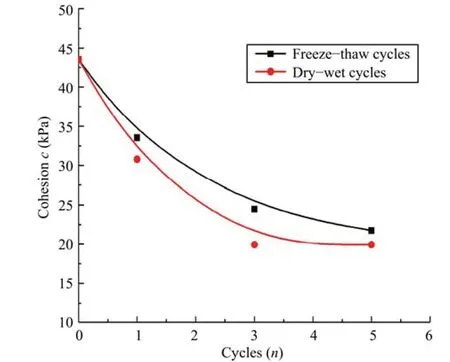
Figure 1 Change of cohesion under different numbers of cycles
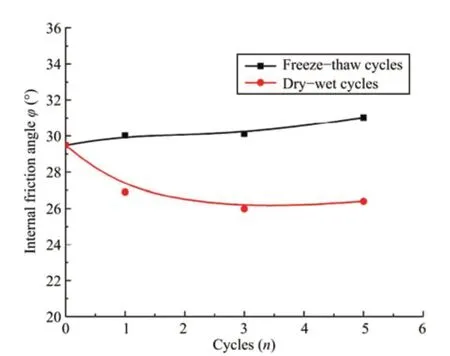
Figure 2 Change of internal friction angle under different numbers of cycles
3 Mathematical model of unsaturated soil
3.1 Control equation of unsteady temperature field

The heat-conduction partial differential equation for the unsteady temperature field of a plane problem is obtained by the heat-transfer theory:In the formula, T is the transient temperature; t is the duration time; λ is the thermal conductivity; ρ is the density; Cpis the constant-pressure specific-heat capacity; qνis the internal heat-source intensity; and x,y are the rectangular coordinate.
According to the literature (Wang, 2014), we can see that the above equation is a nonlinear problem;the calculation is difficult. In the case of phase-transition problem by the solid-phase increment method,the differential equation of the plane unsteady thermal conduction with phase transition is:

In the formula, L is the soil-freeze or -melt phasechange latent heat; fsis the solid-phase rate.
For solid-phase rate,non-phase change zone:

phase change zone:

In the formula, Tuand Tfare melting and freezing temperatures; Wuis the unfrozen water content of the soil;T is the phase-change node temperature.
3.2 Determination of temperature boundary conditions
According to the related theory of heat transfer,the current temperature boundary conditions mainly have the following three categories:

It is the temperature value or temperature function on the boundary.

In the formula, n is the outer normal direction of the calculation-domain temperature boundary; Tsand Tfis the temperature on the calculation-domain temperature boundary,respectively; KTis the heat-exchange coefficient of the material in the domain.

In the formula,n is the direction of the normal outside the border; qhis a known function, that is, the heatflux density at the boundary of the known numerical model.
4 Numerical model of rainfall and evaporation in unsaturated soil
4.1 Saturated-unsaturated seepage theory
Through the mass-conservation equation, we can obtain the unsaturated seepage-control differential equation(Zhou et al.,2008):

In the formula,Kijis the saturated permeability tensor;Kr(h) is the relative permeability coefficient; h is the head pressure; C is the water capacity, which is 0 in the saturated zone; β is the volume-compression coefficient of the water, β = 1 in the saturation zone, and β = 0 in unsaturated zone; Ssis the storage rate; S is the source and sink term;t is the time variable.
5 Limit-equilibrium method
The limit-equilibrium method is one of the analytical methods commonly used for evaluating slope stability.It is usually determined by the ratio of the shear resistance along the failure surface of the slope,acting on the potential failure surface of the rock mass, to the shear force of the slope along the failure surface.The following is a brief introduction by the strip method; Figure 4 shows the stress conditions of the soil strip.
Using Fredlund's unsaturated soil-strength formula,that is

Here,c′is the effective cohesive force; φ′is the effective internal friction angle; φbis the strength-increase rate caused by the increase of the matrix suction; and Tmis the shear strength at the lower part of the soil bar.

Here,β is the width of the bottom of the soil;Fsis the stability coefficient; N is the normal stress on the bottom of the soil strip.
And N can be obtained by the following formula:

Here, M is the severity of the rectangular strip of area h×b;XRis the normal stress on the right side of the soil;XLis the normal stress on the left side of the soil;and α is the angle between the bottom of the soil strip and the horizontal direction.
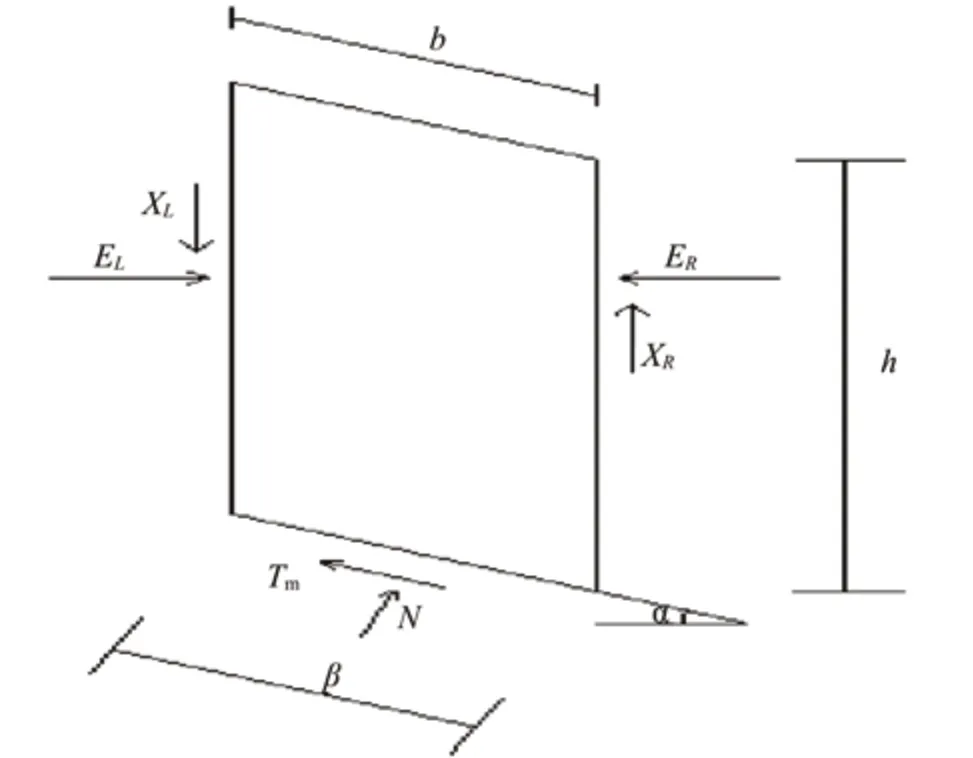
Figure 3 The force of the soil
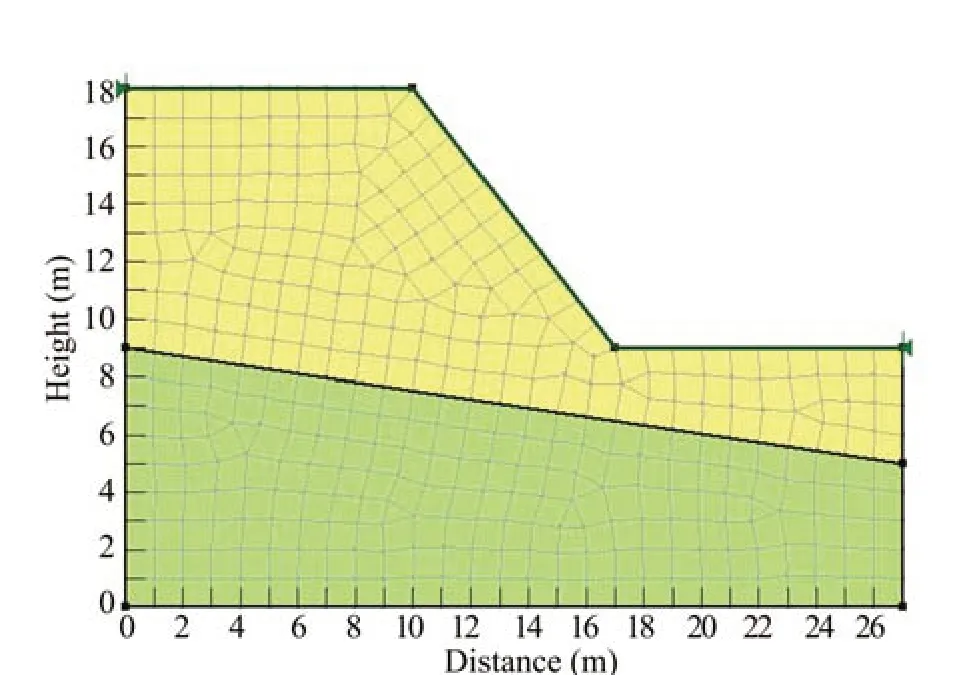
Figure 4 Slope grid division
6 Engineering example analysis
6.1 General situation of engineering
This article selected the typical loess high slope at the Baolan Passenger Line for the research object.The shallow layer of the high slope is mainly Malan loess, and the deep layer is mainly Lishi loess. The length of the model slope is 10 m, the slope height is 14 m, the slope angle is 60.9°, and the slope extends longitudinally for a relatively long distance. According to elastic-plastic mechanics knowledge, the model can be regarded as two-dimensional-plane strain problem. This model took into consideration factors such as the time step and boundary conditions and so on.A quite dense mesh dividing is carried out on the shallow area of the surface of the slope crest and the potentially dangerous sliding surface. The influence of the climate on the slope is not significant, so the mesh segmentation is relatively loose. There are 622 meshes and 584 nodes in the slope analysis, as shown in Figure 4.
6.2 Thermodynamics and hydraulics parameters
Thermal conductivity and specific-heat capacity are two important parameters in the process of heat conduction. Thermal conductivity is positively related to dry density and moisture content. In this article, according to the test results about the coefficient of thermal conductivity and specific-heat capacity of Wang et al.(2007), the full thermal model selected. Thermal conductivity of unfrozen Malan loess soil was selected as 2.85 kJ/(h·m·°C), the specific-heat capacity is 2,509 kJ/(m3·°C), the thermal conductivity of frozen soil is 3.06 kJ/(h·m·°C), and the specific heat capacity is 2,638 kJ/(m3·°C).Thermal conductivity of Lishi loess is 3.31 kJ/(h·m·°C), the specific-heat capacity is 2,565 kJ/(m3·°C), the thermal conductivity of frozen soil is 3.53 kJ/(h·m·°C), and the specific-heat capacity is 2,761 kJ/(m3·°C).The relationship of thermal conductivity to the temperature and the unfrozen moisture content to the temperature are shown in Figure 5 and Figure 6.
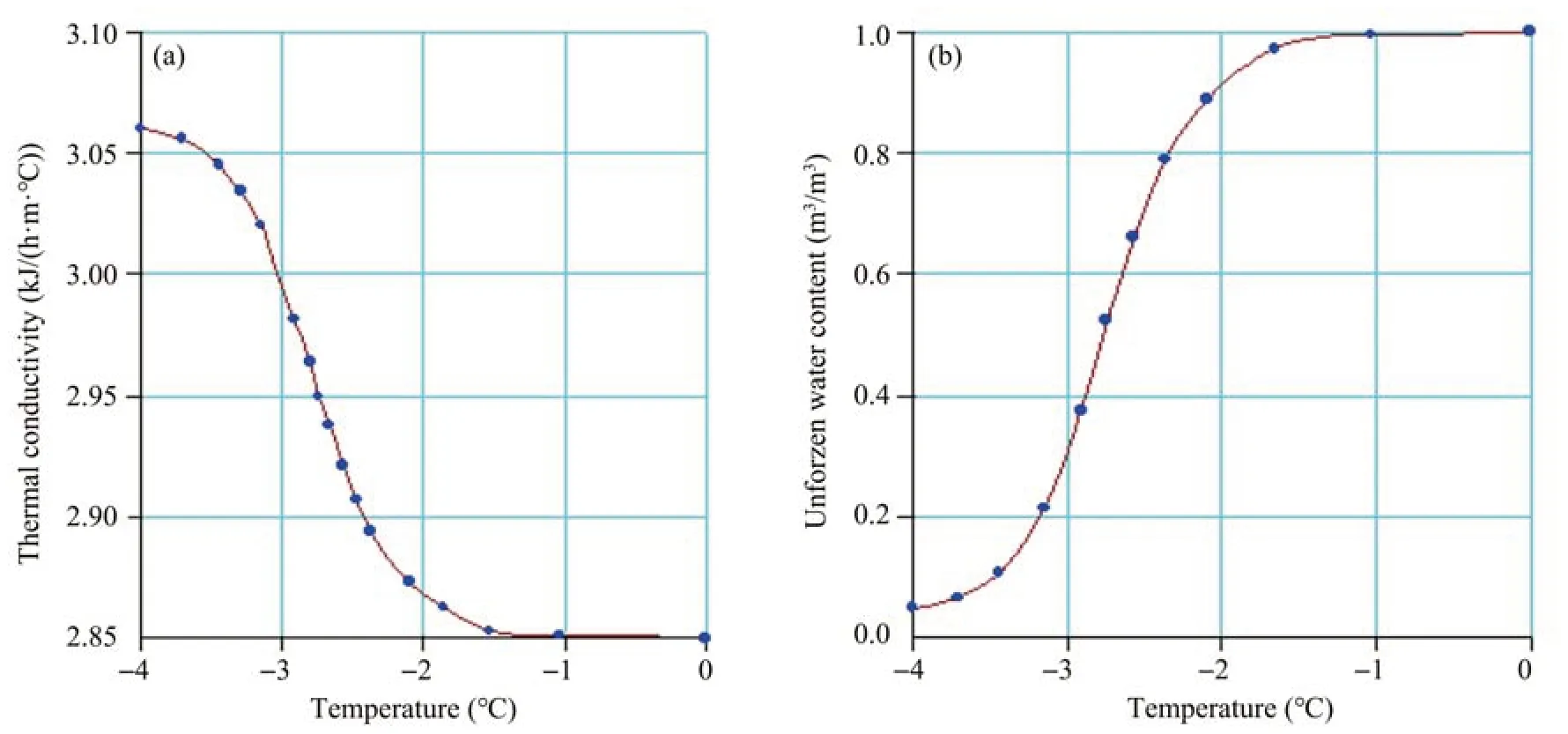
Figure 5 Malan thermal conductivity and unfrozen-water content/temperature chart:(a)thermal conductivity vs.temperature;and(b)unfrozen-water content vs.temperature
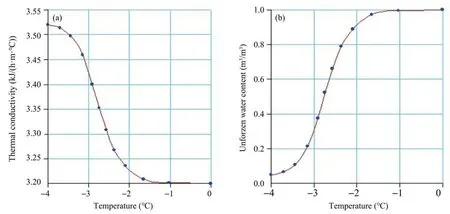
Figure 6 Lishi thermal conductivity and unfrozen-water content/temperature chart:(a)thermal conductivity vs.temperature;and(b)unfrozen-water content vs.temperature
In calculation of the unsaturated soil slope, two important hydraulic parameters need to be established in the model: the soil-water characteristic curve and the soil-permeability function. In this article, the hydraulic parameters used in the calculation process were selected from the SEEP/W function library (GEO-SLOPE International Ltd., 2011). Figure 7 and Figure 8 show the soil-water characteristic curves and permeability-function curves of the two soils.

Figure 7 Malan soil-water characteristics and permeability-function curve:(a)soil-water characteristics curve;and(b)permeability-function curve
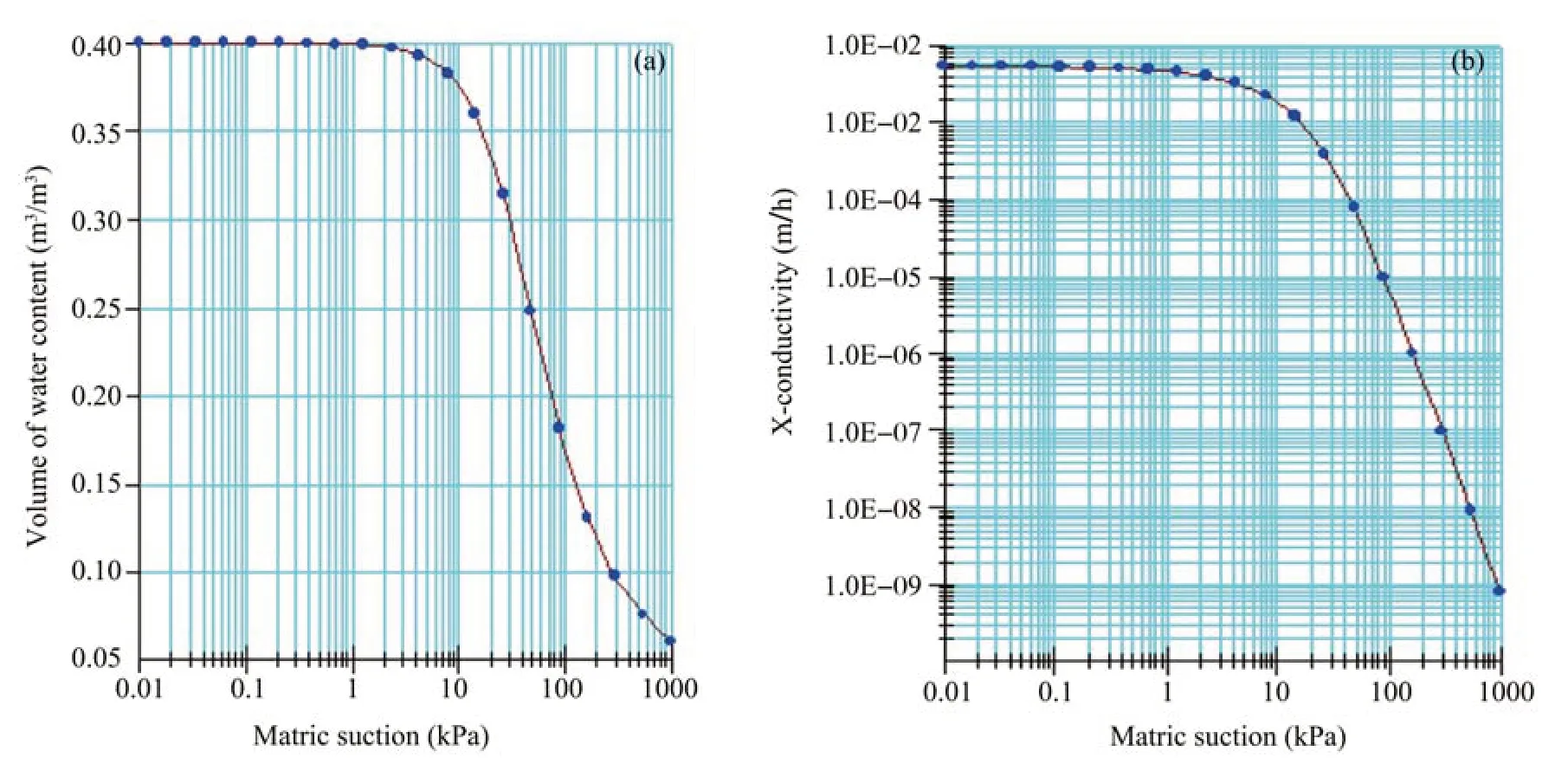
Figure 8 Lishi soil-water characteristics and permeability-function curve:(a)soil-water characteristics curve;and(b)permeability-function curve
6.3 Temperature boundary conditions
According to heat-transfer theory, there are three main types of the temperature boundary conditions at present:

that is, the temperature value or temperature function on the boundary.

In the formula, n is the outer normal direction of the temperature boundary in the calculation domain; Tsand Tfare the temperatures at the temperature boundary of the calculation domain; and KTis the heat-exchange coefficient of the material in the domain; that is,the thermal convection boundary conditions.

In the formula,n is the boundary of the exterior normal direction; qhis a known function, that is, the heat-flux density at the boundary of the known numerical model.
As a typical representative of the Northwest China climate, the Lanzhou region is in the temperate continental climate range, with an annual average temperature of 10.3 °C. The annual average precipitation is 327 mm; and it's mainly concentrated over 5-9 months, mainly as moderate or light rain. As seen from Table 3, from November to February of the following year, the area is cold and receives less rain; the temperature fluctuates around 0 °C; and the soil undergoes freezing and thawing alternately during the day, which is a severe period of the freezethaw action (Wang et al., 2009). In this 5-9 months each year, continental and monsoon instability is prominent; the total rainfall is less but concentrated,with most of the rainfall concentrated in this period.The infiltration of the rainfall causes the soil-water content to increase; and evaporation also extracts water from the soil, so that the soil-moisture content alternates with the endless changing. This article chose the real-time monitoring temperature as the boundary conditions of the freeze-thaw slope in Table 2.
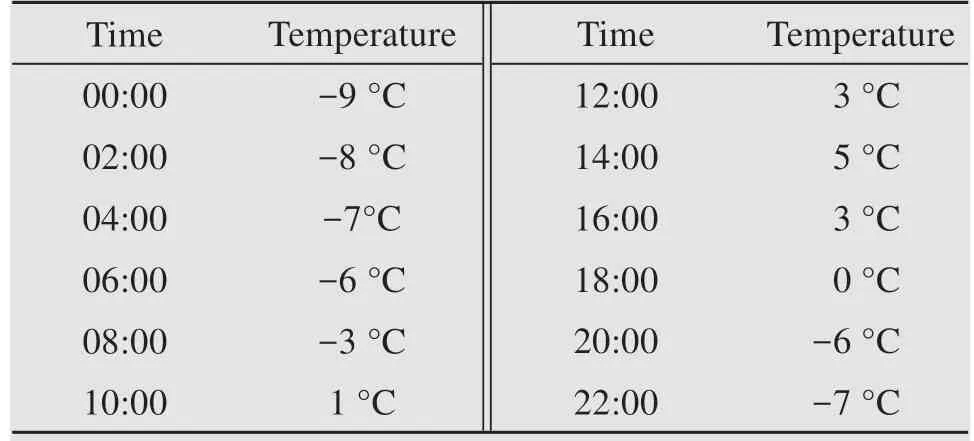
Table 2 Real-time monitoring temperature on December 2,2016
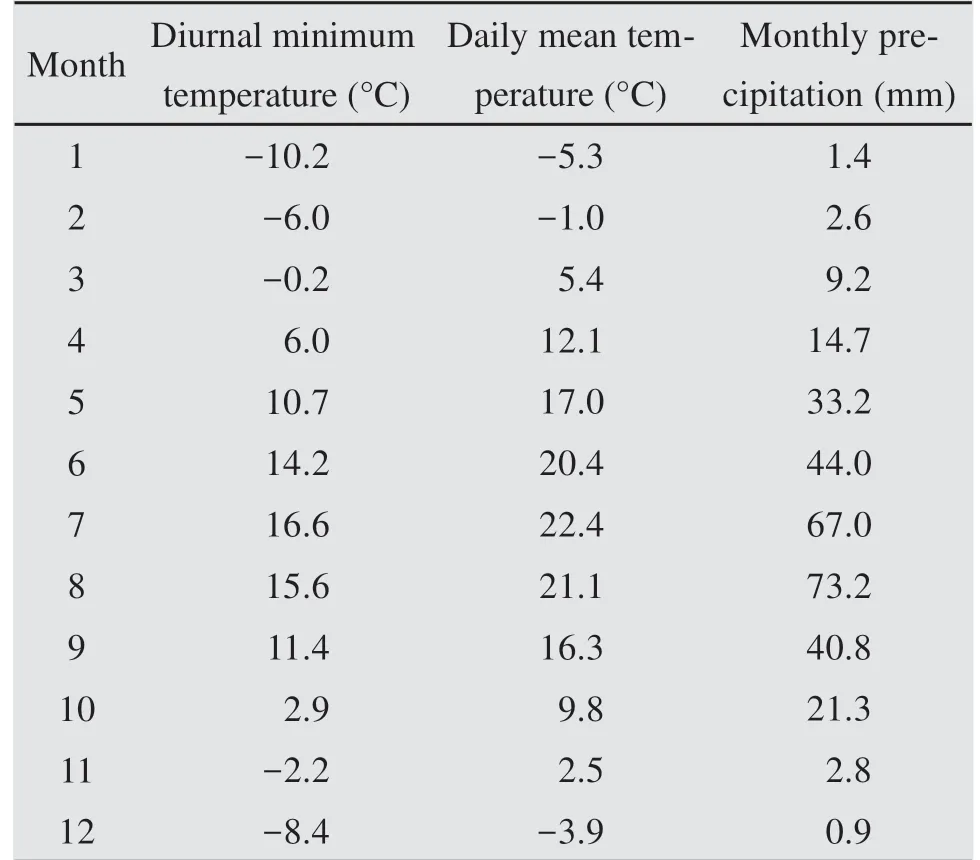
Table 3 Lanzhou annual climate profile(1971-2000 average)
6.4 Dry-wet boundary condition
Rainfall seepage is related to the permeability coefficient of soil and is mainly divided into three kinds:
When rainfall intensity is less than the saturatedseepage coefficient, the rainwater all seeps down into the soil; at this time, the boundary condition is the flow boundary:

In the formula, ν is the velocity of flow; n is the normal direction of the boundary; νΓ2is the known flux boundary;and q(x,y,t)is a known function.
When the rainfall intensity is greater than the saturated-infiltration coefficient, part of the rainwater infiltrates; and the rest is lost in the form of runoff. At this time,it is the head boundary:

In the formula, Γ1is the seepage-zone boundary; and h1(x,y,t)is the spatial coordinate function.
The water evaporation and the soil-moisture content are closely related (Chen,1997).The initial evaporation intensity is basically constant; but with the loss of the surface water, the evaporation intensity also decreases, so the evaporation boundary condition is expressed as follows:

In the formula, θ is volume moisture content; and fθ(θ)is volumetric water content function.
In a long-term dry climate, the ground surface maintains a low air-dried moisture content.At the moment, the evaporation force is approximately constant,so the evaporation condition is

In the formula,h0is a constant function.
The climate characteristics of the Lanzhou region are considered in an integrated manner, with the actual simplified slope taken as the model, and moderate rain (20 mm/d) (mainly in the form of light rain) was taken as the rainfall condition to explore the change of the rainfall infiltration on the slope. To compare with the model, a different slope angle was selected as the object of study. The boundary condition of the gradient-slope seepage surface was the component of the vertical direction of the seepage surface, which was used as the rainfall intensity of the gradient slope(Chang et al., 2014). The intensity of rainfall in this article is given in m/h, and the specific conversion is shown in Table 4.
Evaporation is calculated by the amount of potential evaporation, while the potential evaporation rate is the evaporation per square meter of surface area(GEOSLOPE International Ltd., 2011), which is known.The daily rainfall minus potential evaporation is entered as a step function. A correction function has a powerful ability that allows the applied flow to depend on the pore-water pressure in the soil. Theoretically, this relationship is the coupling process between the heat and mass flow in the soil;but this process can be simplified according to additional information such as soil-water pressure.The boundary condition of the integrated unit flow can be used to calculate the approximate evaporation rate. The ratio of the actual evaporation to the potential evaporation is a function of the negative porewater pressure (GEO-SLOPE International Ltd., 2011)(Figure 9). When the soil is dry, the absolute value of the negative pore-water pressure becomes larger; and the percentage of daily potential evaporation given by the unit quantity and time function decreases gradually.At each time step,the solver queries the appropriate potential evaporation rate and multiplies it by the percentage value corresponding to any soil-pressure state given in the correction function.The potential evaporation of the soil is based on the literature (Huo, 2008), as shown in Table 5.
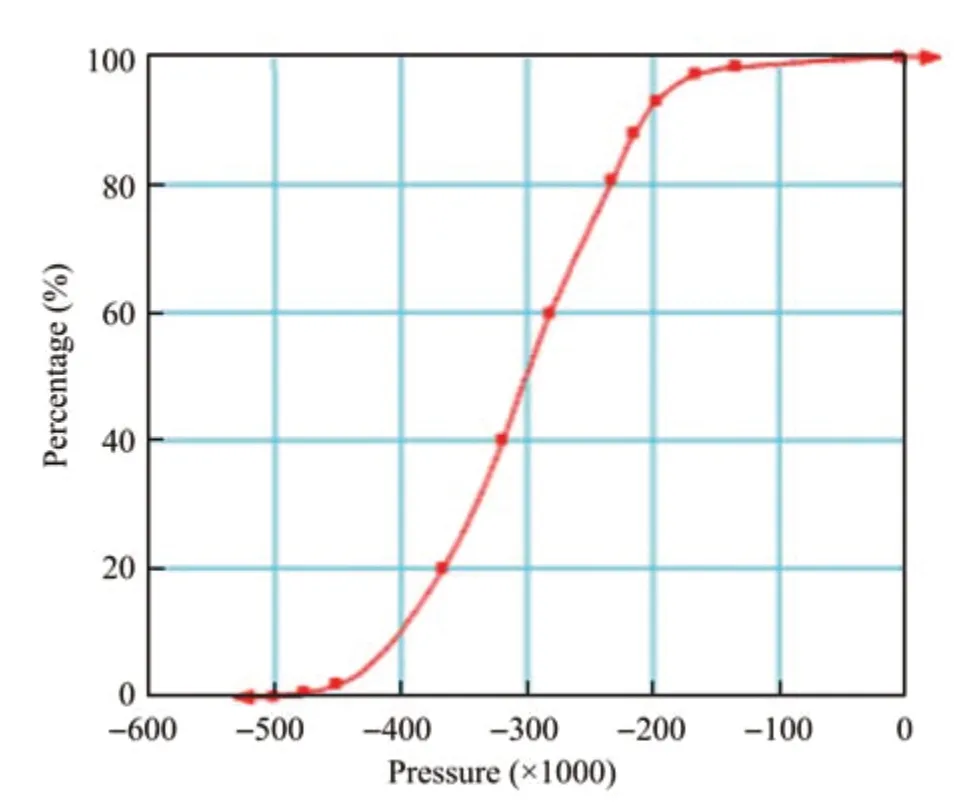
Figure 9 Potential evaporation function(GEO-SLOPE International Ltd.,2011)

Table 4 Rainfall intensity at different slopes

Table 5 Overview of potential evaporation on slopes
6.5 Initial condition
The steady-state temperature field of the slope was calculated by referring to the literature (Li and Yu, 2011) to set the bottom surface as the constant temperature 2 °C and the left and right sides as adiabatic boundary by default. The minimum daily average temperature of 2.9 °C in October was selected as the initial temperature, the initial temperature and the above boundary conditions were calculated until the temperature field was stable, and the stable temperature field was taken as the initial temperature field.
The slope was subjected to the combined action of rainfall and evaporation. The rainfall was the flux boundary, and evaporation was measured according to actual meteorological parameters. It was considered that both sides of the slope do not exchange heat and water with the outside,which was the adiabatic boundary. The slope-surface line was the rainfall and evaporation boundary,and the bottom soil was clay.The permeability coefficient was very small, so it could be assumed to be an impermeable boundary.
6.6 Numerical analysis
In this section, the actual slope (with the slope angle of 60.9°) was taken as an example to illustrate the influence of the freeze-thaw cycle and dry-wet alternation on the temperature field and seepage field of the slope. To make the conclusion more convincing,this article selected 51.3°and 45.0°slopes for comparative analysis,to explore the change of the slope-safety factor under the different slope gradients.
6.6.1 Freeze-thaw cycle
As shown in Figure 10, the change of the temperature at the foot of the slope was relatively severe compared with that of the slope;and the temperature of the slope was raised by 0.1 °C/m and about 0.2 °C/m at the foot of the slope. The initial condition of the climate temperature was taken after the distribution of the steady-temperature field had been calculated, and the transient temperature field calculations were performed based on the transient temperature boundary conditions.
As can be seen from Figures 11-13, the surface temperature of the slope changed drastically in the case of the repeated freeze-thaw cycles; and change of the internal temperature of the slope was relatively gentle. As the freeze - thaw cycles continued, the depth of the effect of the freeze-thaw action on the slope continued to deepen.
After one freezing period, the frozen depth of the slope surface was about 40 cm. In the first melting stage, the temperature of the slope surface increased,the frozen surface of the slope surface was almost completely melted, and the slope and the shallow layer remained at the high temperature. After the third freeze,the frozen depth of the slope was about 50 cm.In the melting stage, an isothermal closed circle was formed, due to the constant change of temperature inside and outside the slope when the slope and the surface were subjected to repeated freeze-thaw cycles.Under the fifth freezing action,the frozen depth of the slope reached about 85 cm.This result was due to the Lanzhou winter temperature, which was below zero for a period longer than when at the positive temperature, and compared to the positive temperature, the minus temperature was lower, so the frozen soil continued to deepen.According to the numerical calculation, it was assumed that the frozen depth of the soil was about 120 cm after the slope experienced 30 days of freeze-thaw cycles; but the actual frozen depth of the slope in the Northwest region was about 90 cm.This result was because the unsaturated soil is a complex three-phase structure, with thermal conductivity of the water, the gas, and the soil being different; and thermal conductivity of the soil is greater than that of the water and the gas, which is more conducive to the conduction of temperature.
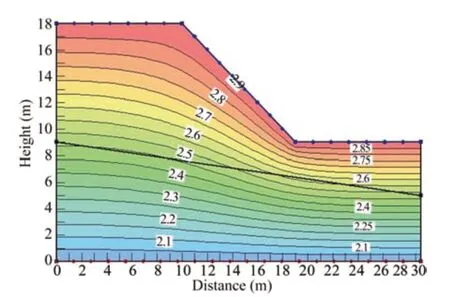
Figure 10 Temperature field distribution
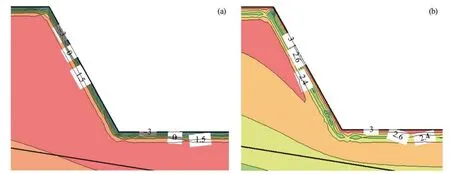
Figure 11 Temperature field distribution of a freezing and thawing slope:(a)temperature field distribution of one freeze;and(b)temperature field distribution of one thaw
6.6.2 Dry-wet alternation
Soil from the slope,at a depth of 0.5 m,was selected to analyze,as is shown in Figure 14;the slope shoulder A,the midpoint C,and the slope foot B were selected to analyze the effect of the evolution law of dry-wet circulation under the different gradients on the negative pore-water pressure and the volumetric water content.
Figures 15 to 17 show the variation of the negative pore-water pressure and volumetric water content over time with different slope gradients. The changes in the negative pore-water pressure and the volume moisture content of the slope shoulder A,the midpoint C and the slope foot B were cyclically rising. But as time went on, the slope of the curve became smaller because the water film existing on the slope surface impeded the infiltration of the rainwater as the rainfall continued. On account of the different slope gradients, the negative pore-water pressure and the volumetric water content on the gradient slope were different, and which caused the rainfall on the slope were not the same as the evaporation on the slope. The negative pore-water pressure and the volumetric water content of the different gradients of the slope showed increasing trends over time.This finding was because, as compared to the steep slope, the gentle slope could keep the rain on the surface of the slope longer,the infiltration was more complete, the impact of kinetic energy suffered from the rain was also greater,and the water supply in the interior of the slope could be more fully.
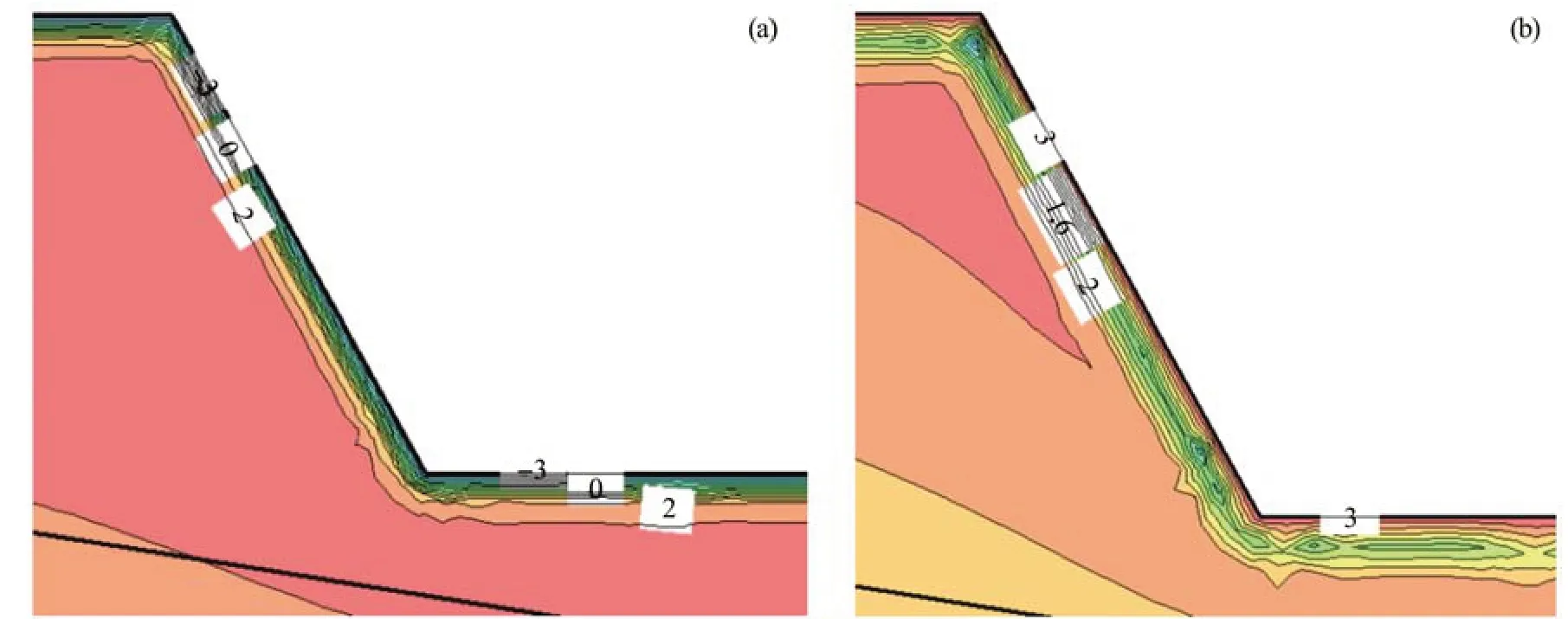
Figure 12 Temperature field distribution of a freezing and thawing slope:(a)temperature field distribution of 3 freezes;and(b)temperature field distribution of 3 thaws
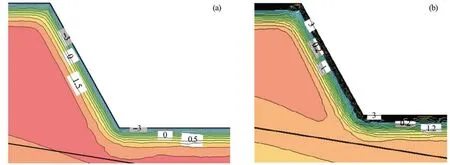
Figure 13 Temperature field distribution of a freezing and thawing slope:(a)temperature field distribution of 5 freezes;and(b)temperature field distribution of 5 thaws
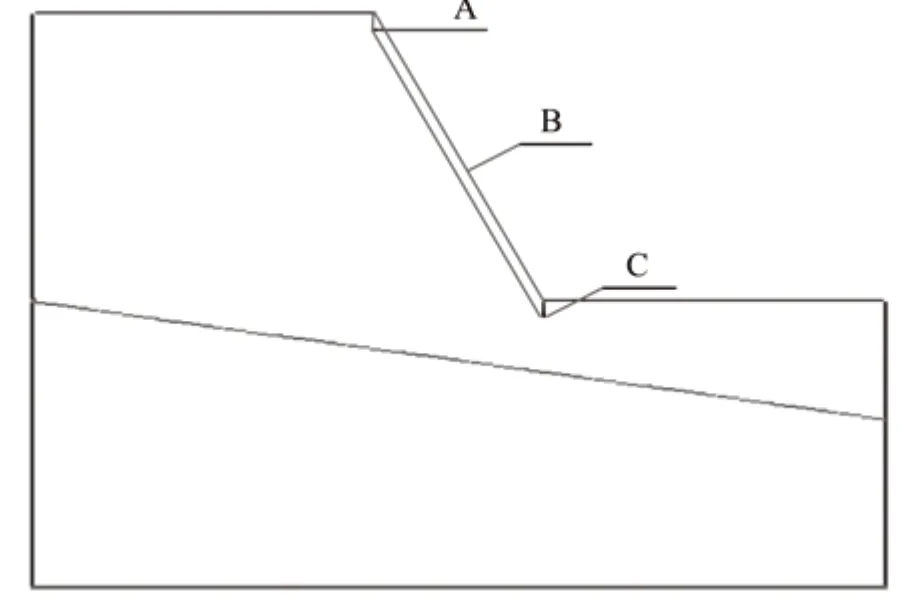
Figure 14 Schematic diagram of the slope
6.7 Study on slope stability of different slopes
From the test results of Table 1, this article took into the account the extreme climate conditions and selected the most unfavorable combinations to analyze slope stability. For the freeze-thaw slope, it was known from the literature (Chang et al., 2014) that different temperatures had a weaker effort on the shear mechanical properties of the soil, so the shear parameters in the indoor test were chosen on the calculation basis of the Malan loess; the weight of the soil sample was 18.7 kN/m3.
The choice of the shear-strength parameters of the Lishi loess could be found in the Engineering Geological Manual (Chang and Zhang, 2007): a bulk density of 19 kN/m3,a cohesive force of 45 kPa,and an internal friction angle of 30°. For the dry-wet slope, rainfall evaporation was a complex process of the coupling of the water and the heat;it was inappropriate to directly select the shear parameters,so this article coupled the seepage-analysis results to the SLOPE/W to get the stability-change rule. In addition, the unsaturated-soil slope required that the contribution of the matrix suction to the safety factor of the slope be considered. The change of the matrix suction was set according to the water-characteristis curve of Figures 7a and 8a.
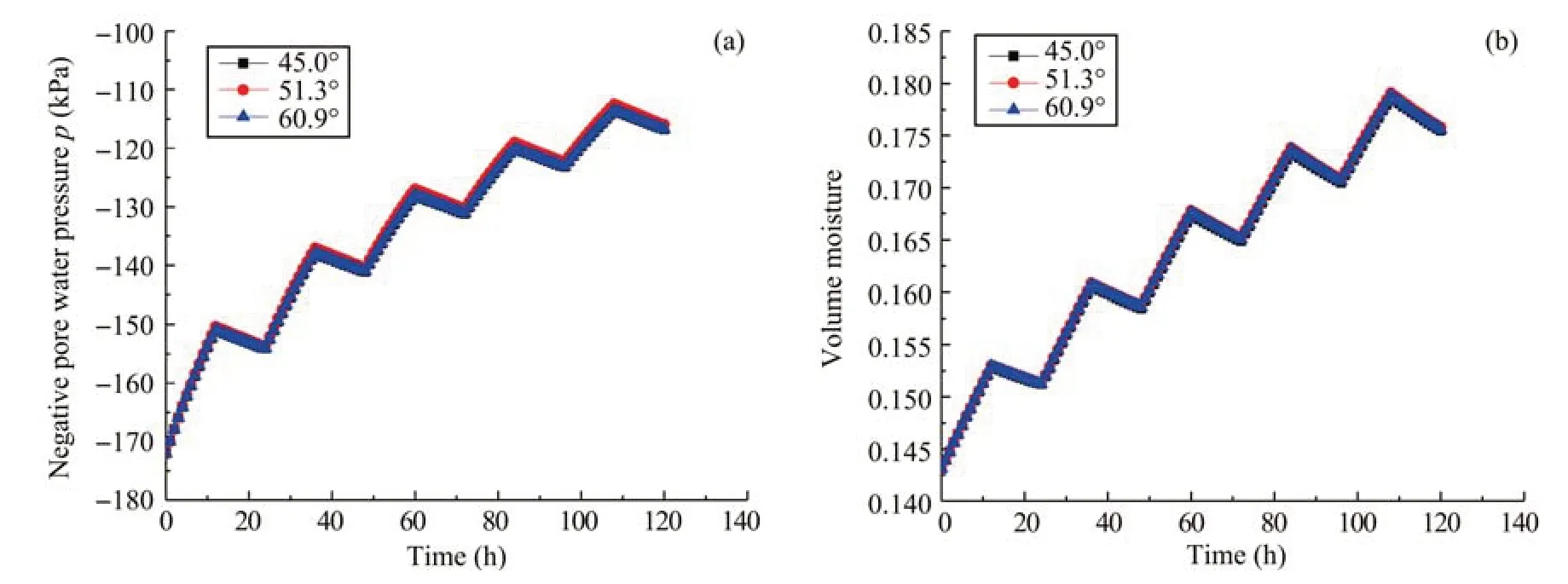
Figure 15 The negative pore-water pressure and volume moisture content at point A vary with time:(a)variation of negative pore-water pressure at point A;and(b)volume moisture change at point A
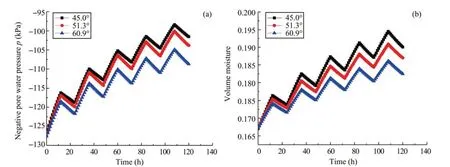
Figure 16 The negative pore-water pressure and volume moisture content at point B vary with time:(a)variation of negative pore-water pressure at point B;and(b)volume moisture change at point B
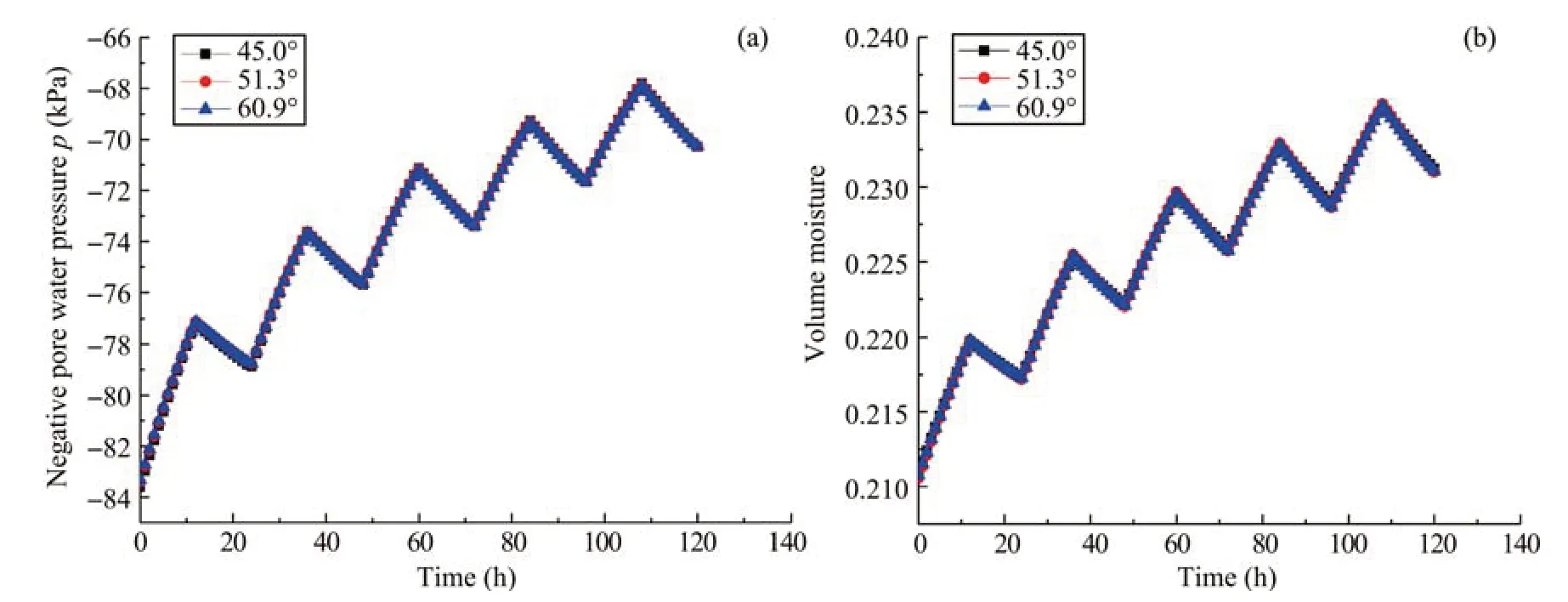
Figure 17 The negative pore-water pressure and volume moisture content at point C vary with time:(a)variation of negative pore-water pressure at point C;and(b)volume moisture change at point C
As can be seen from Figure 18, the safety factor of the slopes of different gradients rapidly decreased during the first rainfall;and there was a partial recovery under the action of evaporation. However, the overall slope-safety factor decreased greatly, which was consistent with the largest decrease of the cohesive force in indoor wet-dry cycle cohesive force after the first cycle. Therefore, it was concluded that the cohesion force is critical to the change of the slope-safety factor.Secondly,with continuous evaporation of the rainfall, the change in the safety factor of the slope was always fluctuating and decreasing gradually. For a 45.0° slope, the safety factor was maintained at a high level; but compared to 51.3°and 60.9° slopes, the previbration of the 45.0° slope was more intense, the amplitude larger. This result is because of that the smaller the slope curve was, the longer the rain stranded on the slope, the more full infiltration would be, and the greater impact of the rain kinetic energy was, finally resulting in the 45.0°slope safety factor in the early evaporation of rainfall changed dramatically. By comparing the slope of 51.3° and 60.9°, it is found that the change curve of slope safety coefficient is intertwined and decreases gradually, this result shows that although in a certain range, the more slow the slope,the higher the stability, but for the rain-sensitive loess, this cognition is not comprehensive, slope stability and seepage strength and slope are related.
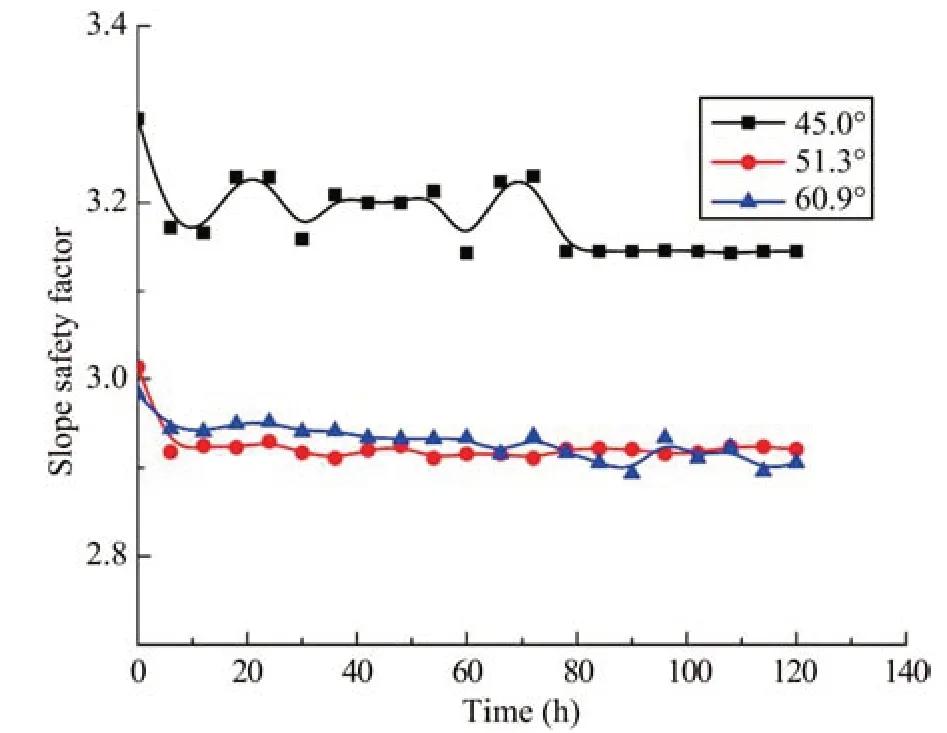
Figure 18 Law of slope-safety factor over time
Figures 19 and 20 reflect the change trend of the slope-safety factor under different conditions of the actions of the freeze-thaw and dry-wet cycles. It can be seen from the Figures 19 and 20 that, compared to the initial state of the slope, the decrease of the slope-safety factor was greater with one cycle of the freeze-thaw and dry-wet circulation.Compared with the slope-safety factor of one cycle of the freeze-thaw and the drywet circulation, 3 and 5 cycles showed a relatively moderate effect;the safety factor of the slope was negatively correlated with the number of cycles. This finding was similar to the change in the number of cycles of cohesion in the indoor test (Figure 2) but not the same as the change in the internal friction angle (Figure 3), indicating that the change of cohesion had a greater impact on the slope-safety factor.Therefore,the decrease of cohesion could be considered an important factor leading to slope instability.It was shown that the change of cohesive force had a greater influence on the slope-safety factor, so it was considered that reduction of cohesive force was an important factor leading to slope failure. The attenuation of the cohesion was closely related to the water content.The higher the water content of the soil, the faster the cohesion. The greater the water content of the soil,the faster the cohesion decayed. The lower the safety of the slope, the more attention should be generated and the more slopedrainage work done. In addition, it could be seen that in slope thawing,the attenuation of the safety factor increased with the increase of the slope; but the understanding of the dry-wet slope was not comprehensive,with the reason illustrated in Figure 18.
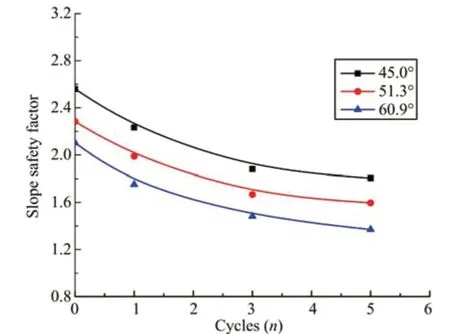
Figure 19 Change of slope safety factor with freeze-thaw cycles
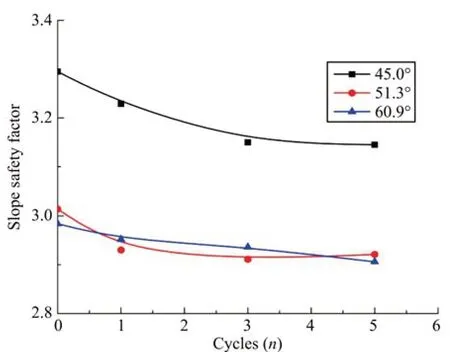
Figure 20 Change of slope safety factor with freeze-thaw cycles
7 Conclusions
This paper took the BaoLin line field slope as a simplified model and discussed the change of the temperature field and the seepage field of the slope under the action of the freeze-thaw cycle and dry-wet alternation, and then provided the basis for the slope-stability investigation of slopes of different gradients.The main conclusions were as follows:
(1) The freeze-thaw cycles were repeated in the slope soil. When the frozen depth of the soil was deepened, the depth of the melting of the soil also increased.And with the freeze-thaw cycles, an isothermal closed loop was formed in the slope.
(2) Under the action of dry-wet circulation, the negative pore-water pressure and the volumetric water content showed a trend of circulating rise; and the negative pore-water pressure and the volumetric water content of the slope shoulder and the slope foot were basically the same. The slope is different from the gradient,which resulted in the different rainfall infiltration.As time went on, the climbing trend gap of the negative pore-water pressure and the volumetric water content of the different gradient slopes gradually widened.
(3) With the freeze-thaw cycle and dry-wet alternation, the slope-safety factor continued to decrease;and in the early rounds, the slope-safety factor decreased faster. In addition, for the freeze-thaw slope,the angle and the safety factor were negatively correlated;that is,the slope was higher and the safety factor of the slope lower. However, the cognize of the dry-wet slope was not comprehensive; slope stability was related to the seepage intensity and the gradient.
Acknowledgments:
This work was supported by the National Natural Science Foundation of China(Grant No.51769013).
 Sciences in Cold and Arid Regions2019年2期
Sciences in Cold and Arid Regions2019年2期
- Sciences in Cold and Arid Regions的其它文章
- Analysis of vegetation changes and dominant factors on the Qinghai-Tibet Plateau,China
- Shifts in community structure and function of ammoniaoxidizing archaea in biological soil crusts along a revegetation chronosequence in the Tengger Desert
- Holocene climatic change reconstructed from trace elements of an aeolian deposit in the southeastern Mu Us Desert,northern China
- The establishment and development of Haloxylon ammodendron promotes salt accumulation in surface soil of arid sandy land
- Editors-in-Chief Guodong Cheng and Ximing Cai
- Review on simulation of land-surface processes on the Tibetan Plateau
